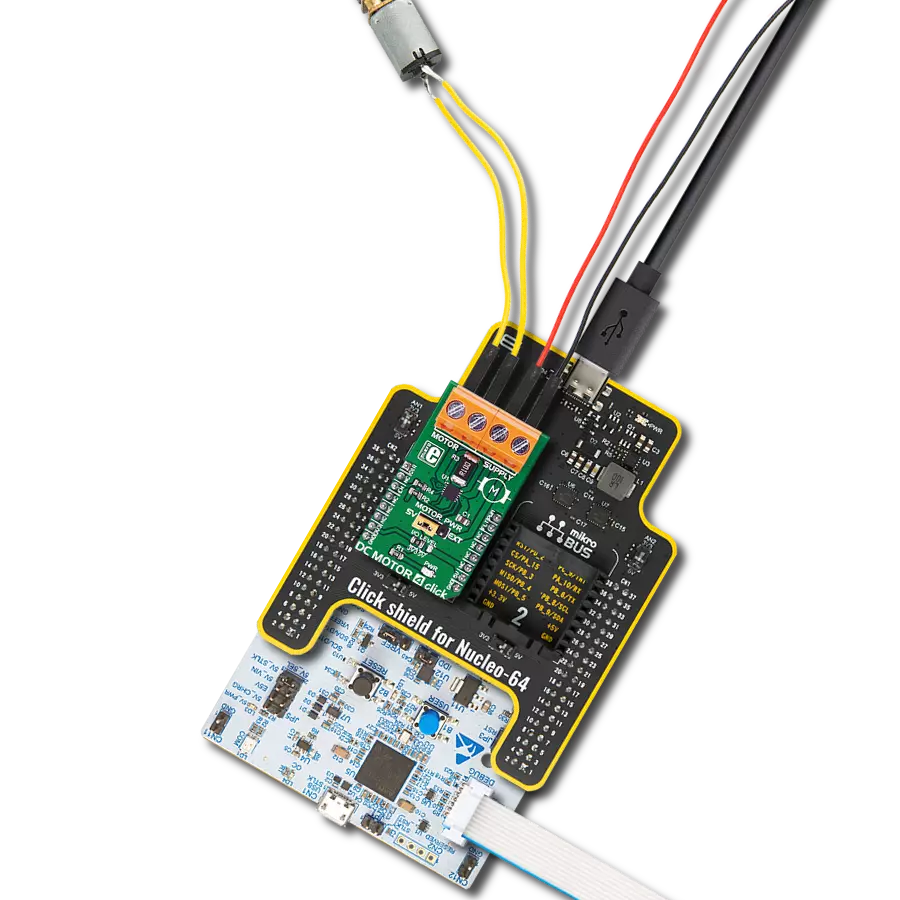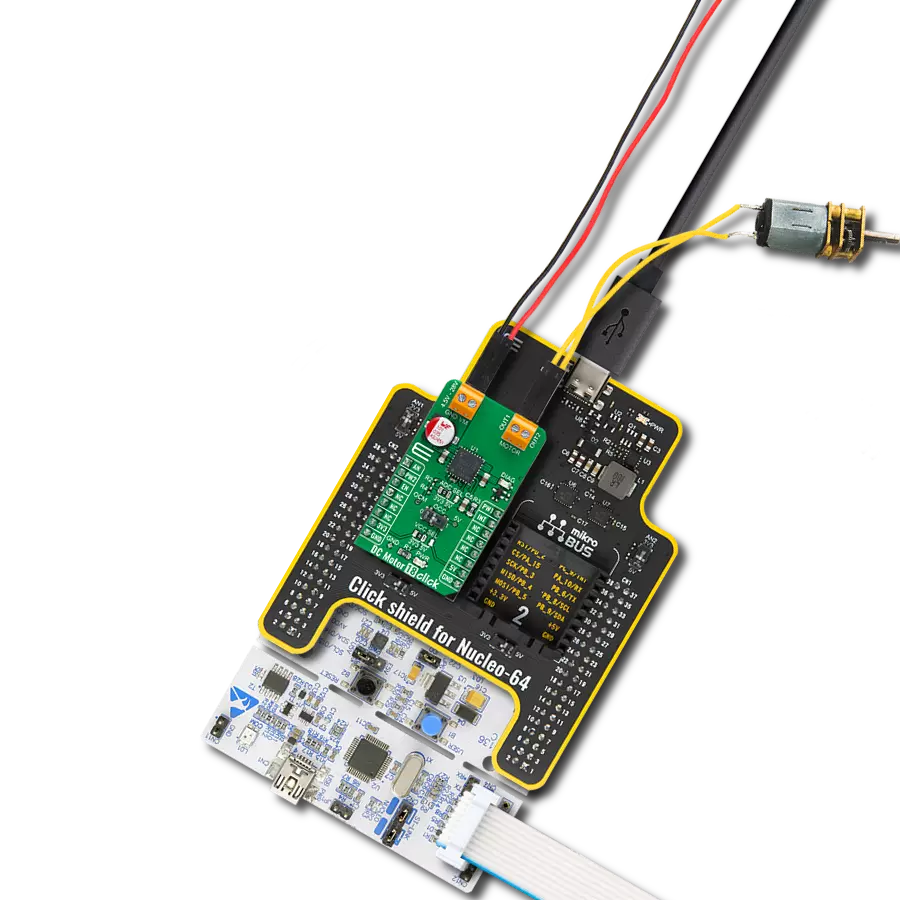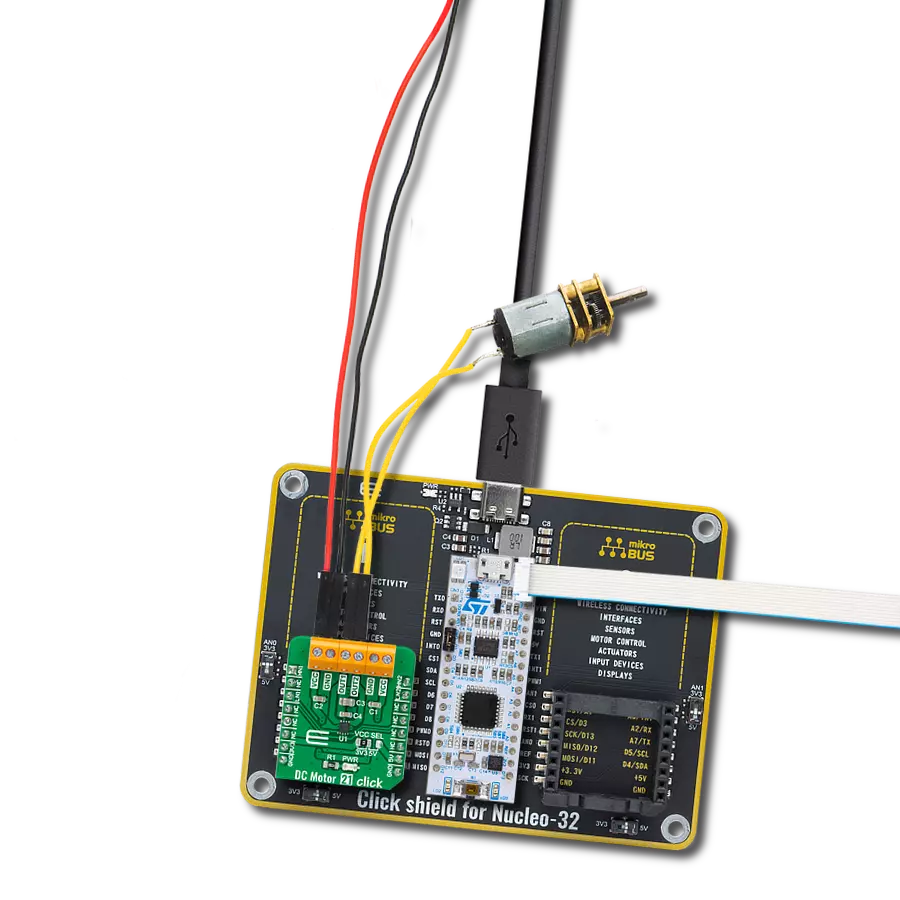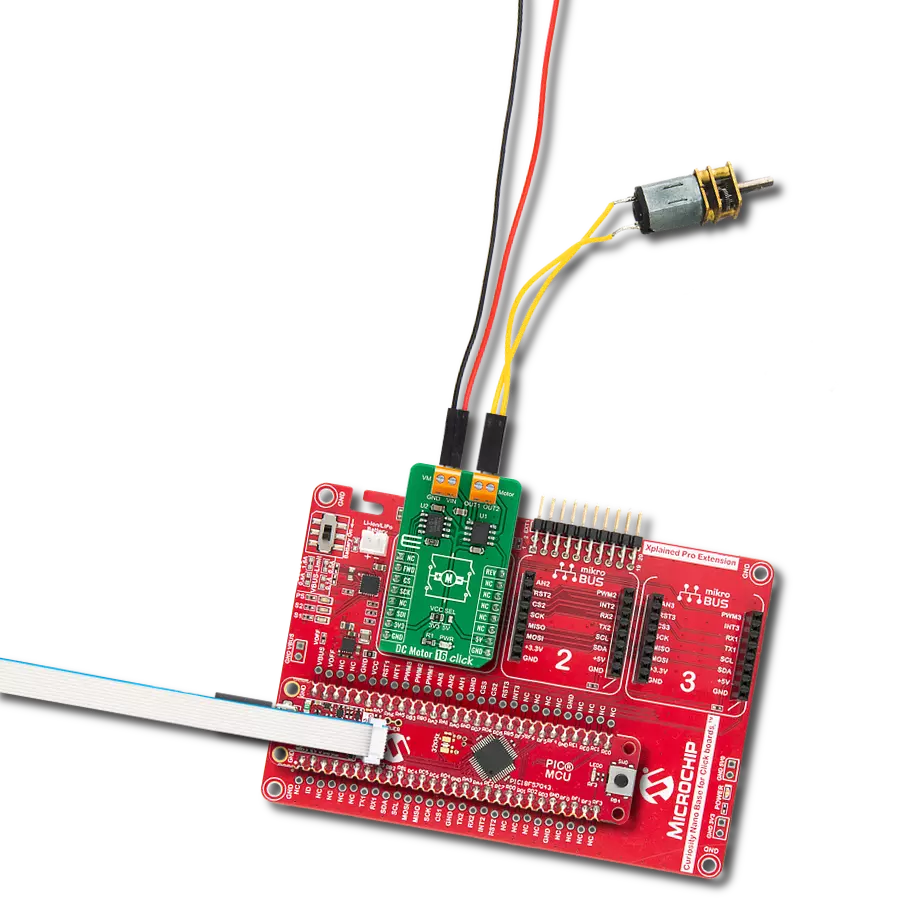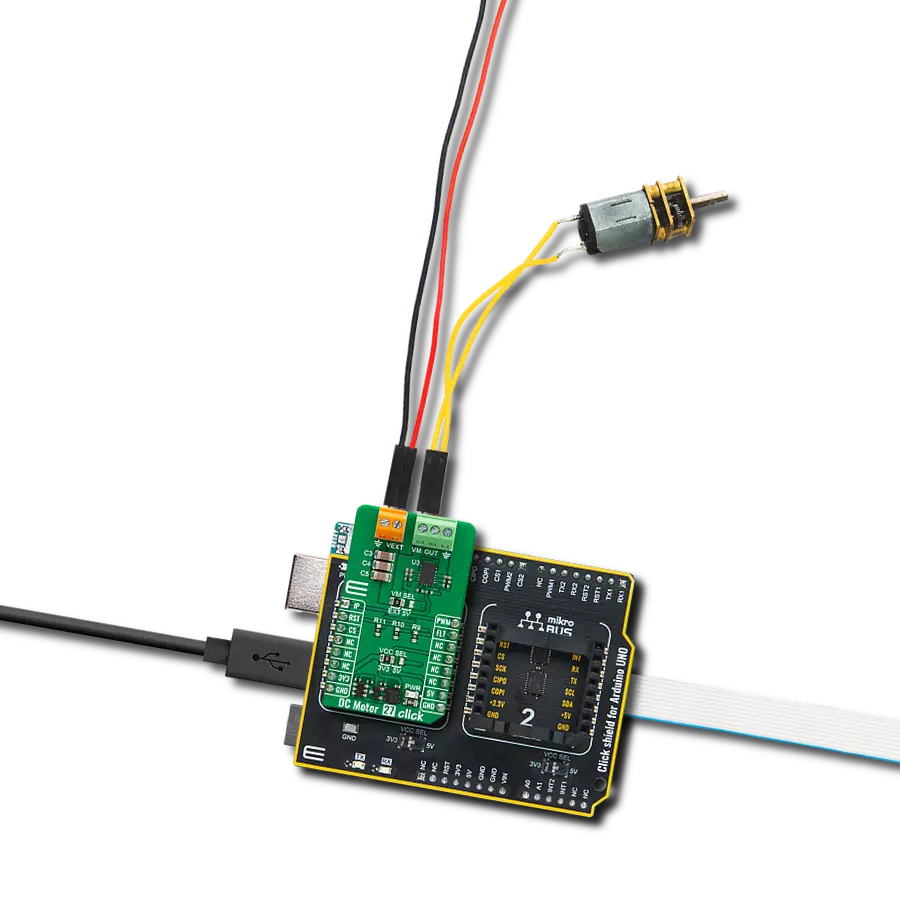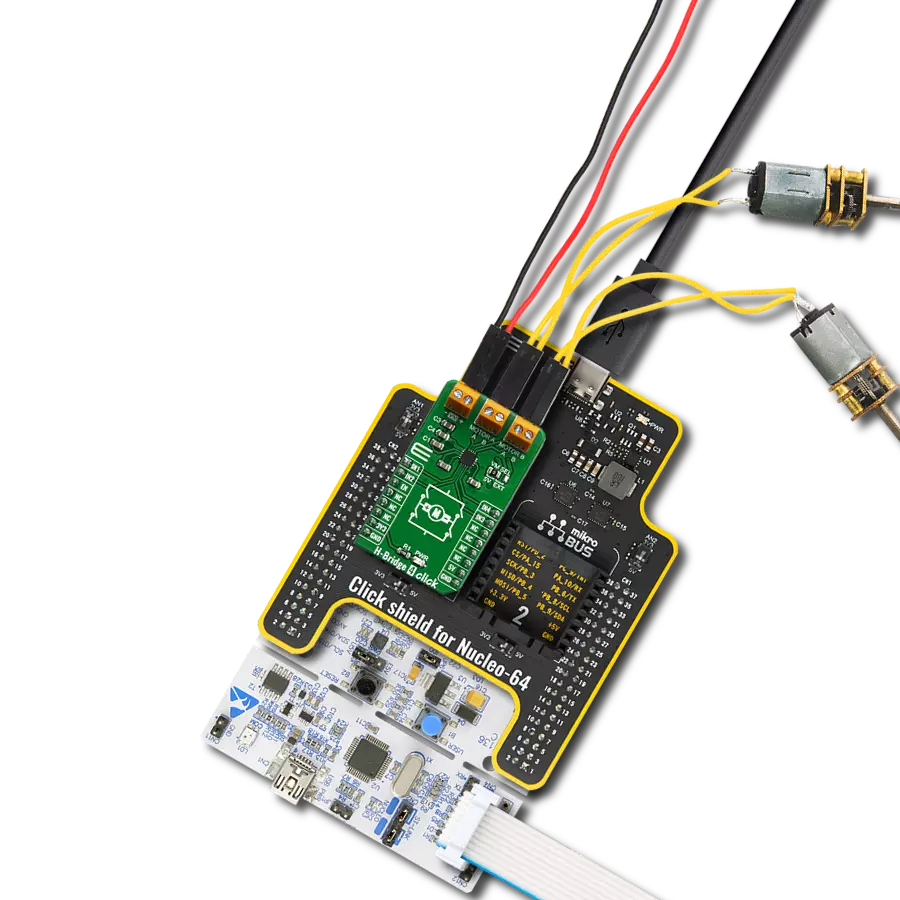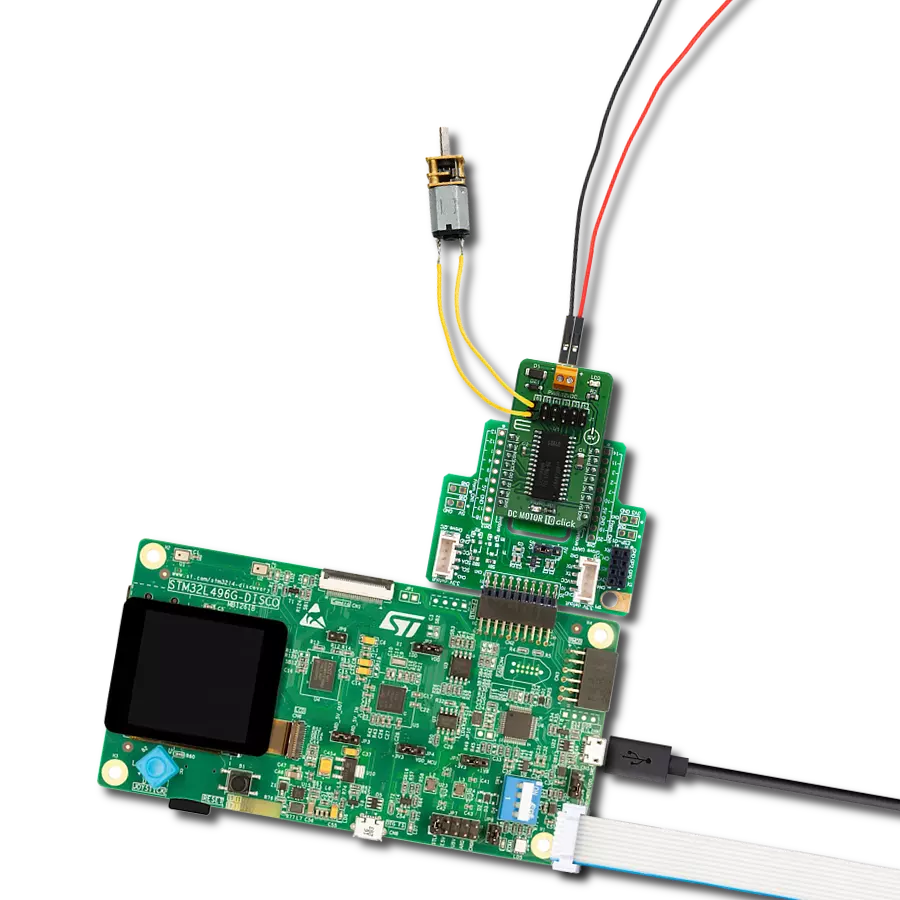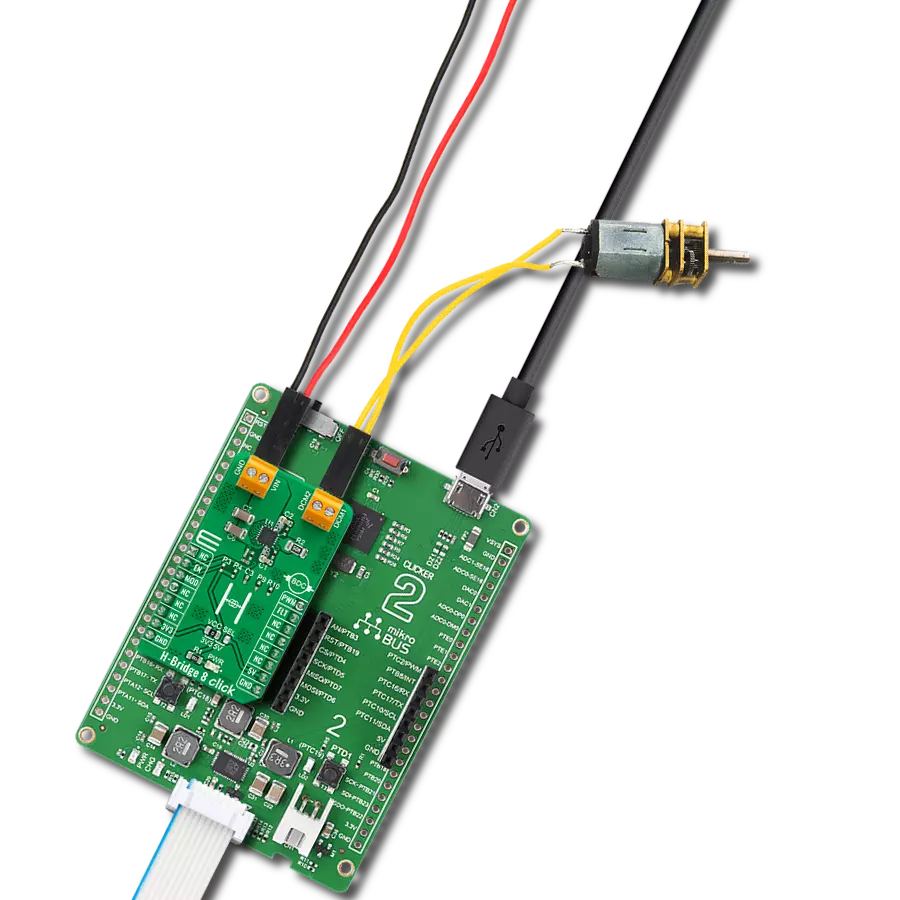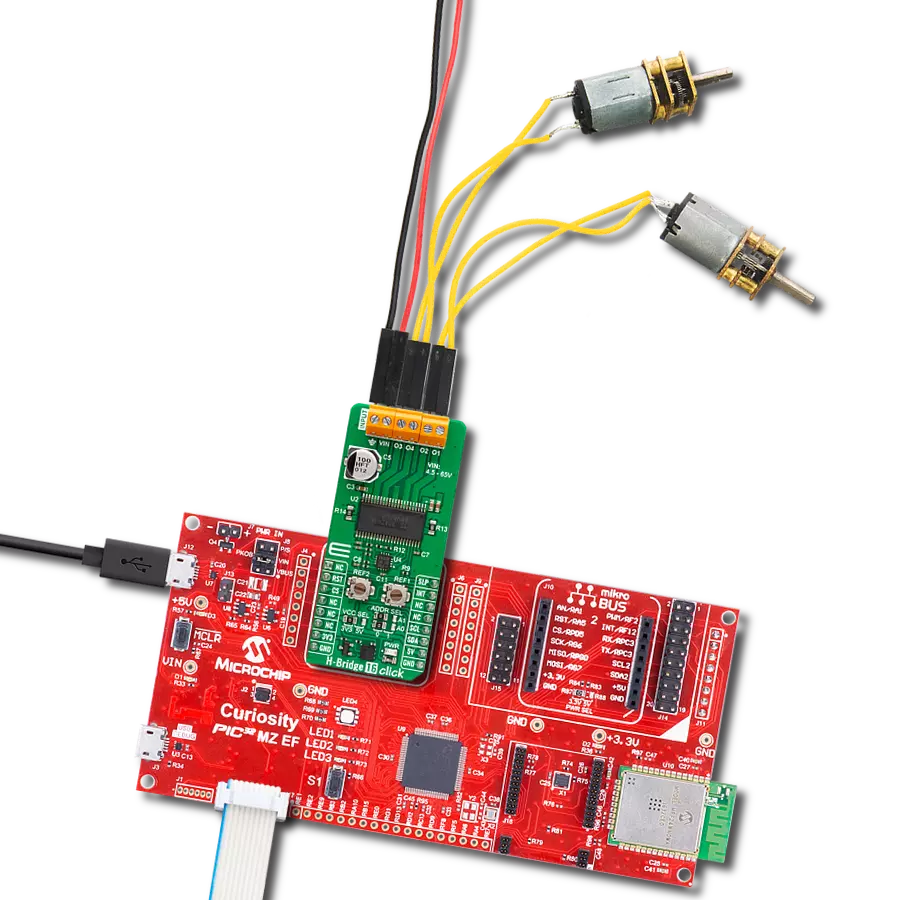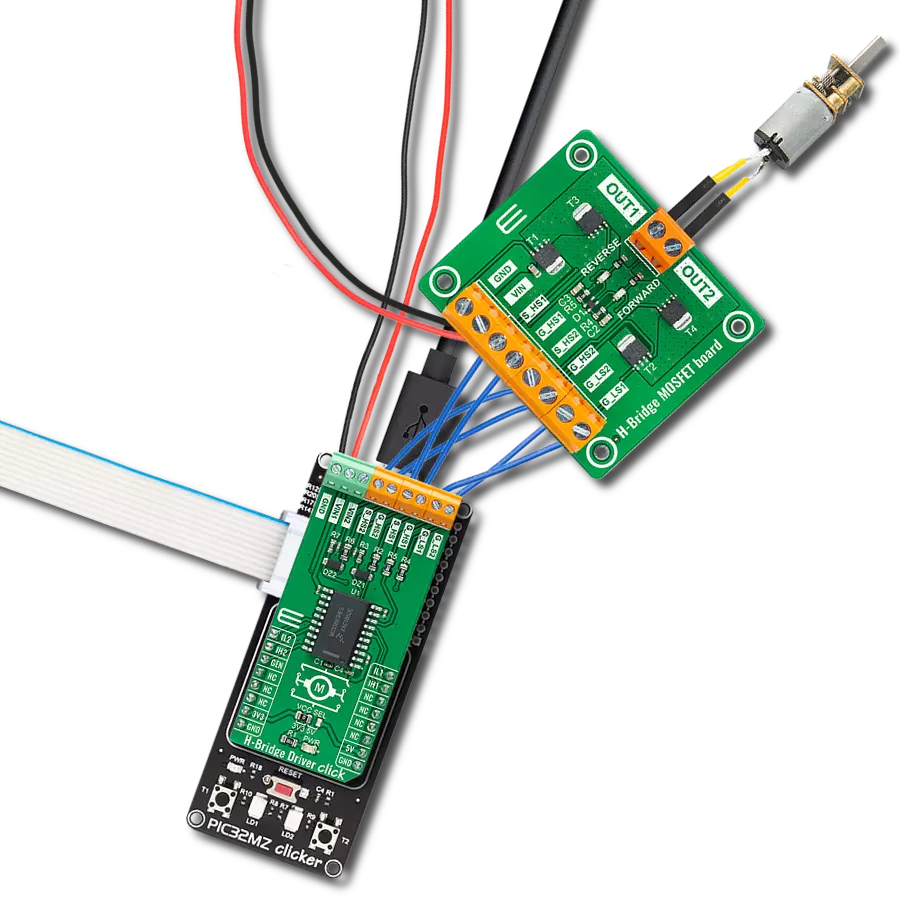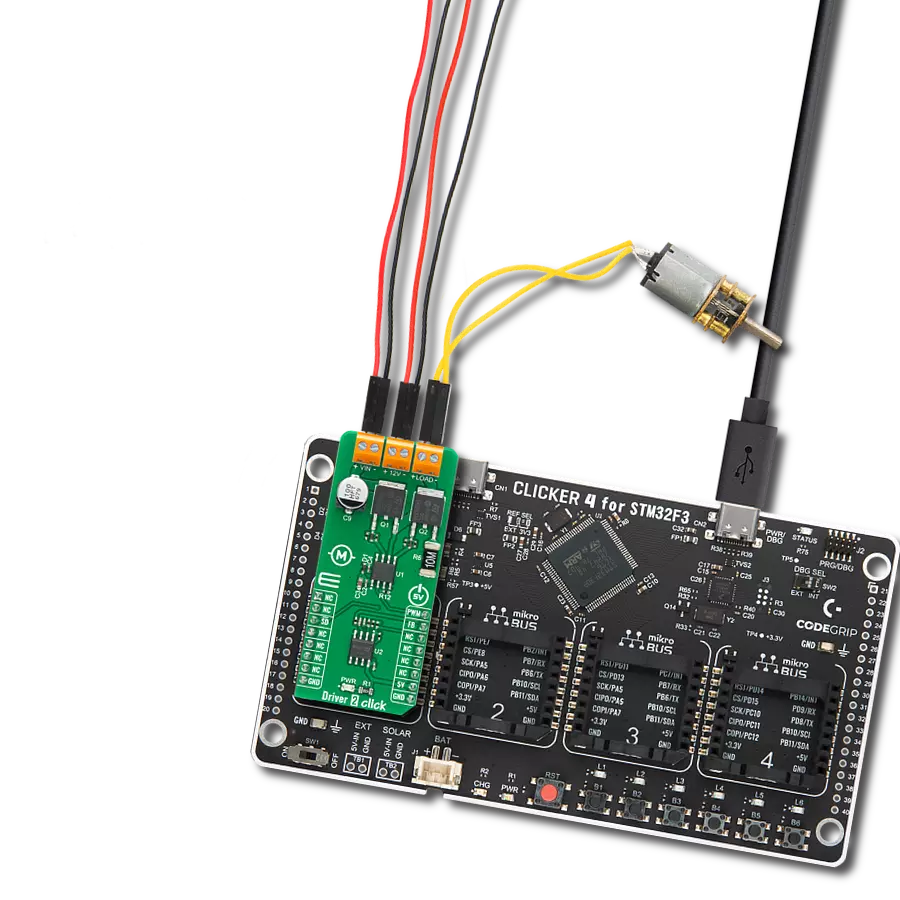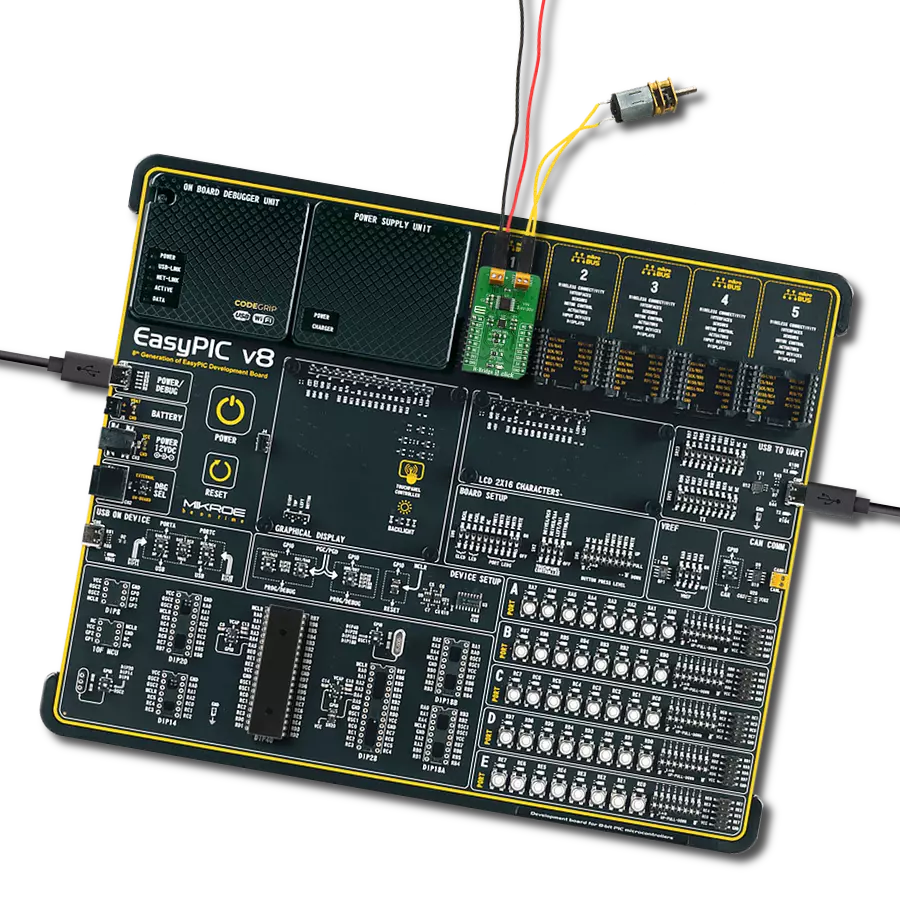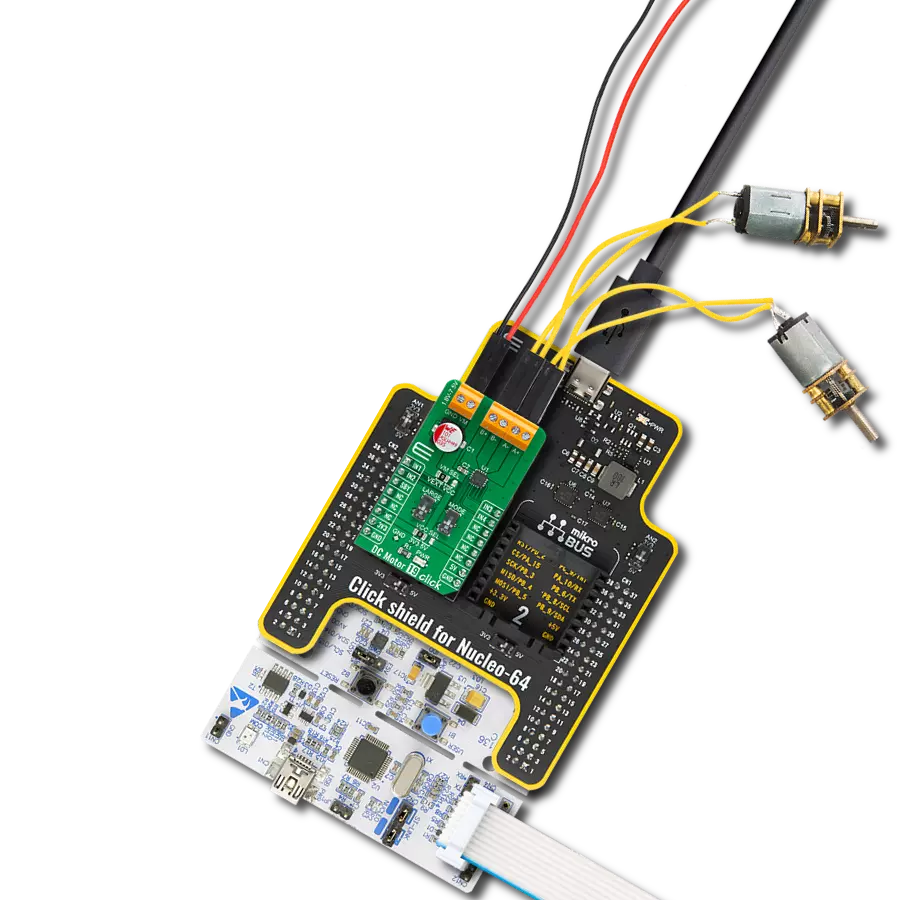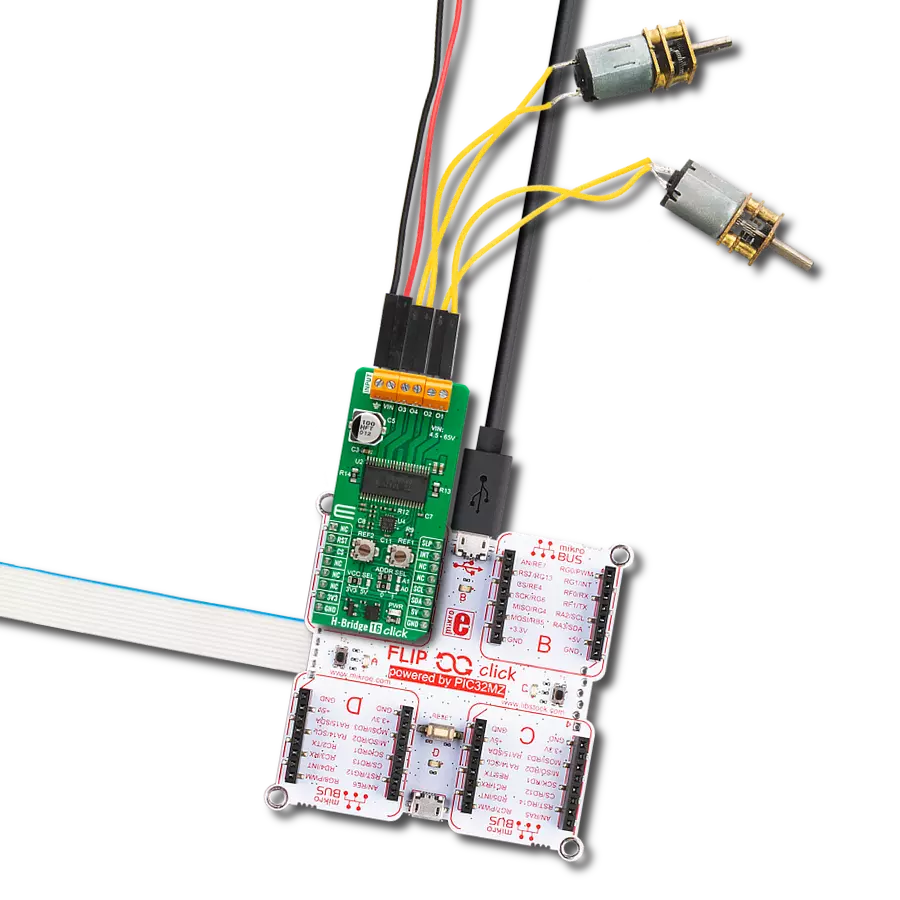With our H-Bridge motor driver solution, you can effortlessly control the rotation and torque of your DC motors, allowing for smooth and precise movement in robotics, automation, and more
A
A
Hardware Overview
How does it work?
H-Bridge 3 Click is based on the TLE9201SG, an H-Bridge DC motor driver, with up to 28V and 6A, from Infineon. This IC is an efficient integrated H-bridge driver with a low RDS ON output per switch. H-bridge, in general, allows the current to flow in one or another direction. All internal supply voltages are derived from the external VIN connector. A charge pump provides the gate voltage for the high-side switches. The output buffer of the digital output SO is supplied by the pin VSO. Therefore the output logic level at SO can be easily configured for 3.3 V or 5 V logic by moving the VCC SEL jumper to the respective voltage. The output stages consist of four n-channel MOSFETs in an H-bridge configuration.
The outputs are protected against short circuits and over-temperature. The bridge is controlled using the inputs PWM and DIR. The signal at DIR defines the direction of the driven DC motor, whereas the PWM signal sets the duty cycle. The outputs can be set tristate (i.e., high side and low side switches are turned off) by setting DIS to a high level. The TLE9201SG is equipped with a “Serial Peripheral Interface“ (SPI) for diagnosis purposes. The H-bridge 3 click is configured as a “slave” device. This means that the host microcontroller, as the master, is providing the chip select (CS) and the clock signal (SCK). A data transfer on the SPI bus is initiated with a falling edge on CS and is terminated by a rising edge
on CS. The serial input pin SI data is sampled with the falling edge of SCK, and the rising clock edge determines the serial data output at MISO. The data is transferred “MSB first. The word length of the SPI is 8-bit. Please note that there is no check for the number of clocks within an SPI frame. Any low pulse at the CS line will be regarded as one frame. This Click board™ can operate with either 3.3V or 5V logic voltage levels selected via the VCC SEL jumper. This way, both 3.3V and 5V capable MCUs can use the communication lines properly. However, the Click board™ comes equipped with a library containing easy-to-use functions and an example code that can be used, as a reference, for further development.
Features overview
Development board
Nucleo-64 with STM32F091RC MCU offers a cost-effective and adaptable platform for developers to explore new ideas and prototype their designs. This board harnesses the versatility of the STM32 microcontroller, enabling users to select the optimal balance of performance and power consumption for their projects. It accommodates the STM32 microcontroller in the LQFP64 package and includes essential components such as a user LED, which doubles as an ARDUINO® signal, alongside user and reset push-buttons, and a 32.768kHz crystal oscillator for precise timing operations. Designed with expansion and flexibility in mind, the Nucleo-64 board features an ARDUINO® Uno V3 expansion connector and ST morpho extension pin
headers, granting complete access to the STM32's I/Os for comprehensive project integration. Power supply options are adaptable, supporting ST-LINK USB VBUS or external power sources, ensuring adaptability in various development environments. The board also has an on-board ST-LINK debugger/programmer with USB re-enumeration capability, simplifying the programming and debugging process. Moreover, the board is designed to simplify advanced development with its external SMPS for efficient Vcore logic supply, support for USB Device full speed or USB SNK/UFP full speed, and built-in cryptographic features, enhancing both the power efficiency and security of projects. Additional connectivity is
provided through dedicated connectors for external SMPS experimentation, a USB connector for the ST-LINK, and a MIPI® debug connector, expanding the possibilities for hardware interfacing and experimentation. Developers will find extensive support through comprehensive free software libraries and examples, courtesy of the STM32Cube MCU Package. This, combined with compatibility with a wide array of Integrated Development Environments (IDEs), including IAR Embedded Workbench®, MDK-ARM, and STM32CubeIDE, ensures a smooth and efficient development experience, allowing users to fully leverage the capabilities of the Nucleo-64 board in their projects.
Microcontroller Overview
MCU Card / MCU
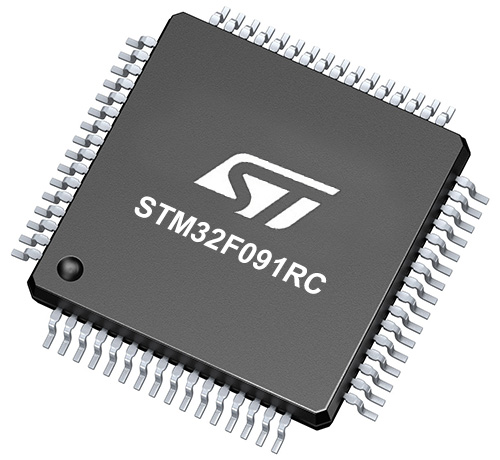
Architecture
ARM Cortex-M0
MCU Memory (KB)
256
Silicon Vendor
STMicroelectronics
Pin count
64
RAM (Bytes)
32768
You complete me!
Accessories
Click Shield for Nucleo-64 comes equipped with two proprietary mikroBUS™ sockets, allowing all the Click board™ devices to be interfaced with the STM32 Nucleo-64 board with no effort. This way, Mikroe allows its users to add any functionality from our ever-growing range of Click boards™, such as WiFi, GSM, GPS, Bluetooth, ZigBee, environmental sensors, LEDs, speech recognition, motor control, movement sensors, and many more. More than 1537 Click boards™, which can be stacked and integrated, are at your disposal. The STM32 Nucleo-64 boards are based on the microcontrollers in 64-pin packages, a 32-bit MCU with an ARM Cortex M4 processor operating at 84MHz, 512Kb Flash, and 96KB SRAM, divided into two regions where the top section represents the ST-Link/V2 debugger and programmer while the bottom section of the board is an actual development board. These boards are controlled and powered conveniently through a USB connection to program and efficiently debug the Nucleo-64 board out of the box, with an additional USB cable connected to the USB mini port on the board. Most of the STM32 microcontroller pins are brought to the IO pins on the left and right edge of the board, which are then connected to two existing mikroBUS™ sockets. This Click Shield also has several switches that perform functions such as selecting the logic levels of analog signals on mikroBUS™ sockets and selecting logic voltage levels of the mikroBUS™ sockets themselves. Besides, the user is offered the possibility of using any Click board™ with the help of existing bidirectional level-shifting voltage translators, regardless of whether the Click board™ operates at a 3.3V or 5V logic voltage level. Once you connect the STM32 Nucleo-64 board with our Click Shield for Nucleo-64, you can access hundreds of Click boards™, working with 3.3V or 5V logic voltage levels.
DC Gear Motor - 430RPM (3-6V) represents an all-in-one combination of a motor and gearbox, where the addition of gear leads to a reduction of motor speed while increasing the torque output. This gear motor has a spur gearbox, making it a highly reliable solution for applications with lower torque and speed requirements. The most critical parameters for gear motors are speed, torque, and efficiency, which are, in this case, 520RPM with no load and 430RPM at maximum efficiency, alongside a current of 60mA and a torque of 50g.cm. Rated for a 3-6V operational voltage range and clockwise/counterclockwise rotation direction, this motor represents an excellent solution for many functions initially performed by brushed DC motors in robotics, medical equipment, electric door locks, and much more.
Used MCU Pins
mikroBUS™ mapper
Take a closer look
Click board™ Schematic

Step by step
Project assembly
Software Support
Library Description
This library contains API for H-Bridge 3 Click driver.
Key functions:
hbridge3_set_duty_cycle- This function sets the PWM duty cyclehbridge3_spi- This function sends SPI command and receives response to command senthbridge3_generic_transfer- Generic SPI transfer, for sending and receiving packages
Open Source
Code example
The complete application code and a ready-to-use project are available through the NECTO Studio Package Manager for direct installation in the NECTO Studio. The application code can also be found on the MIKROE GitHub account.
/*!
* @file
* @brief HBridge3 Click example
*
* # Description
* H-bridge in general, allows the current to flow in one or another direction.
* This Click is used for driving a H-Bridge motor by changing output states.
* The outputs can be pulse width modulated at frequencies up to 20kHz by means of PWM/DIR control.
*
* The demo application is composed of two sections :
*
* ## Application Init
* Initializes SPI and LOG modules, AN, RST, CS and PWM pins
*
* ## Application Task
* This example demonstrates the use of H-Bridge 3 Click board,
* by running dc motor in both directions - increasing and decreasing PWM duty cycle.
* Results are being sent to the Usart Terminal where you can track their changes.
*
*
* @author Nikola Peric
*
*/
// ------------------------------------------------------------------- INCLUDES
#include "board.h"
#include "log.h"
#include "hbridge3.h"
// ------------------------------------------------------------------ VARIABLES
static hbridge3_t hbridge3;
static log_t logger;
uint8_t motor_direction = 0;
// ------------------------------------------------------ APPLICATION FUNCTIONS
void application_init ( void )
{
log_cfg_t log_cfg;
hbridge3_cfg_t cfg;
/**
* Logger initialization.
* Default baud rate: 115200
* Default log level: LOG_LEVEL_DEBUG
* @note If USB_UART_RX and USB_UART_TX
* are defined as HAL_PIN_NC, you will
* need to define them manually for log to work.
* See @b LOG_MAP_USB_UART macro definition for detailed explanation.
*/
LOG_MAP_USB_UART( log_cfg );
log_init( &logger, &log_cfg );
log_info( &logger, "---- Application Init ----" );
// Click initialization.
hbridge3_cfg_setup( &cfg );
HBRIDGE3_MAP_MIKROBUS( cfg, MIKROBUS_1 );
hbridge3_init( &hbridge3, &cfg );
Delay_ms ( 500 );
hbridge3_pwm_start( &hbridge3 );
log_info( &logger, "---- Application Task ----" );
log_printf( &logger, "> CLOCKWISE <\r\n" );
}
void application_task ( void )
{
static int8_t duty_cnt = 1;
static int8_t duty_inc = 1;
float duty = duty_cnt / 10.0;
hbridge3_set_duty_cycle ( &hbridge3, duty );
log_printf( &logger, " Duty: %d%%\r\n", ( uint16_t )( duty_cnt * 10 ) );
Delay_ms ( 500 );
if ( 10 == duty_cnt )
{
duty_inc = -1;
}
else if ( 0 == duty_cnt )
{
duty_inc = 1;
if ( motor_direction == 1 )
{
log_printf( &logger, "> COUNTER CLOCKWISE <\r\n" );
motor_direction = 0;
hbridge3_dir_set ( &hbridge3 , 0 );
}
else if ( motor_direction == 0 )
{
log_printf( &logger, "> CLOCKWISE <\r\n" );
motor_direction = 1;
hbridge3_dir_set ( &hbridge3 , 1 );
}
}
duty_cnt += duty_inc;
}
int main ( void )
{
/* Do not remove this line or clock might not be set correctly. */
#ifdef PREINIT_SUPPORTED
preinit();
#endif
application_init( );
for ( ; ; )
{
application_task( );
}
return 0;
}
// ------------------------------------------------------------------------ END
Additional Support
Resources
Category:Brushed




















